
- Index
- Artist
- Antonio Devity (4)
- Arthur Hierer (2)
- Charles Levier (3)
- Illegible (5)
- Illegible Signature (56)
- Jean Daumier (3)
- Julius Polek (3)
- L. Sihiinzel (4)
- London (4)
- Maren (3)
- Max Ernst (5)
- Reinald Morgen (3)
- Remedios Varo (7)
- See Description (9)
- T.bailey (4)
- Unknown (107)
- Unsigned (7)
- Vasselli (2)
- Yu Liang Jin (3)
- Yu Yin Xin (4)
- Other (862)
- Framing
- Item Length
- Material
- Size
- Unit Of Sale
William Alfred Hofstetter Antique Man Portrait Oil Painting Double Sided Horses
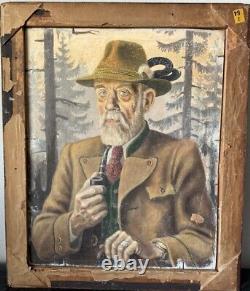
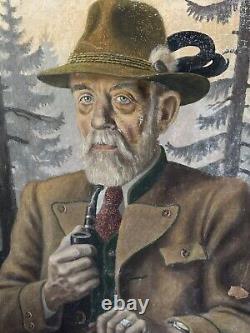
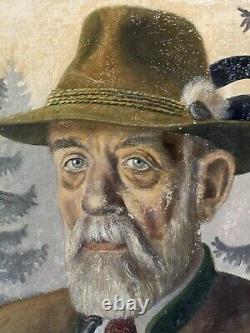
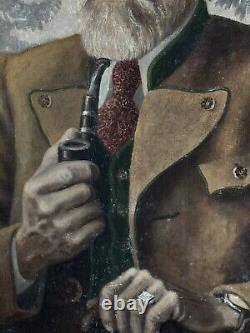
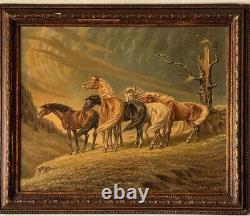
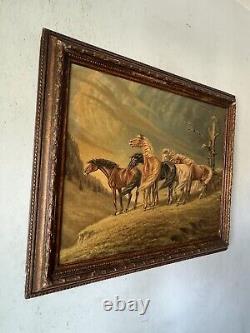
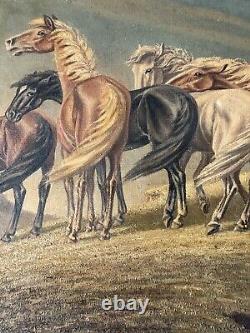
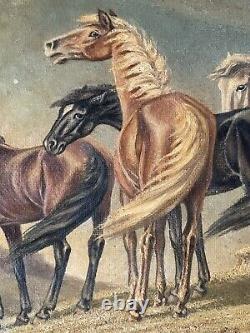
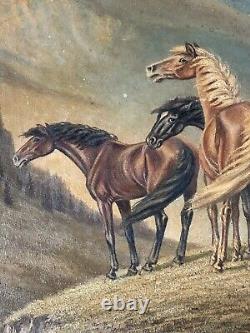

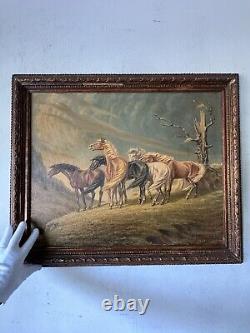
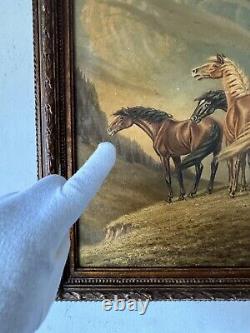
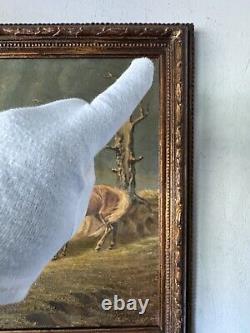
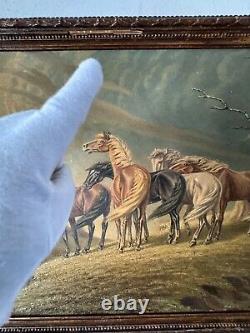
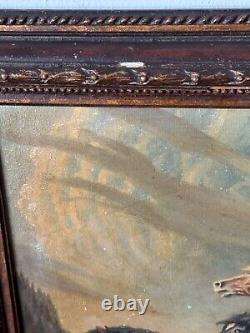

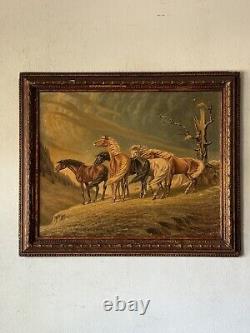
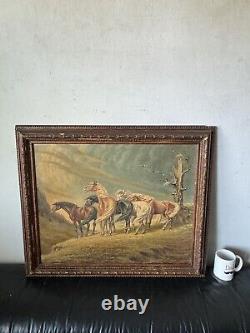
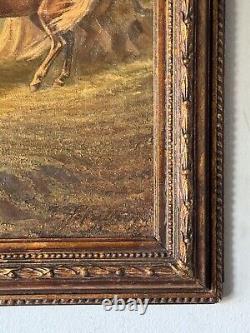
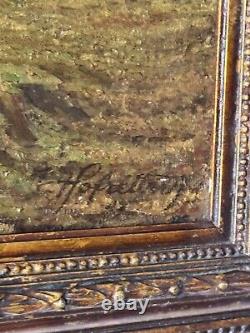


RARE AND MASTERFUL ANTIQUE DOUBLE-SIDED IMPRESSIONIST OIL PAINTING ON BOARD BY THE MASTER OF SUNLIGHT AND SHADOW PAINTER WILLIAM ALFRED HOFSTETTER. THIS WORK IS COMPRISED OF TWO DISTINCTIVE SCENES. ON ONE SIDE, THE PAINTING CAPTURES A REALISTIC PORTRAIT OF A DISTINGUISHED BEARDED MAN ELEGANTLY DRESSED WITH A PIPE IN HAND. HIS ATTIRE IS METICULOUSLY DETAILED, REFLECTING A HIGH LEVEL OF REALISM AND SOPHISTICATION. ON THE OTHER SIDE, THE PAINTING TRANSITIONS TO A GROUP OF WILD HORSES POSING IN A VAST HILLY LANDSCAPE. WILLIAM ALFRED HOFSTETTER IS ONE OF THE EARLY HUDSON RIVER SCHOOL MASTERS, DUB THE MASTER OF SUNLIGHT AND SHADOW, AS SHOWN HERE THESE REMARKABLE PAINTINGS. THIS PIECE IS SIGNED BY HOFSTETTER IN THE LOWER RIGHTHAND CORNER. IT DATES AROUND THE 1920s. MILD PAINT LOSS ON BOTH SIDES AND WEAR TO THE FRAME, AS SHOWN. IT DOES NOT DETRACT FROM ITS BEAUTY IN ANY WAY.
DIMENSIONS: 26"W x 31"H. DIMENSIONS WITHOUT THE FRAME: 26" W x 21" H. William Alfred Hofstetter (1883 - 1970) was active/lived in Pennsylvania, New York. William Hofstetter is known for Landscape, figure-genre, religious easel and mural painting.
The artist takes the liberty to pry into the wonderful secrets which nature possesses and bring them forth in his own manner, so that the general public may enjoy its beauties. Hofstetter, Christian Science Monitor (1927). William Alfred Hofstetter was born 15 July 1883 in Philadelphia, Pennsylvania, to a family of seven children. Even as a boy Hofstetter was always drawing.
Pyle's contributions to American art have gained almost mythical proportions today, and the numerous talents which emerged from his "Brandywine School" include N. Hofstetter followed his teacher's vigorous advice to throw your heart into your painting and leap in after it. Hofstetter did this and more.He also learned to place a strong emphasis on sound draftmanship and a carefully conceived composition. His effort and talent were soon to pay off as he received one of Drexel's top awards in their annual exhibition in the category of Drawing from Life. Upon completion of course work at Drexel, Hofstetter enrolled at the Pennsylvania Academy of the Fine Arts in 1902.
Not able to afford the luxury of being a full time student, Hofstetter studied at the Academy at night and worked as a commercial artist during the day. His passion, however, remained fine art. While absorbing the sound academic traditions from the Academy, he became increasingly influenced by the antithesis of these teachings in the ideas of the French impressionists.It was the revelations of impressionism that provided the freedom Hofstetter most needed for his work. He later wrote: a studied technic robs the artist of his true emotions, enslaves him to the academic and destroys the unexpected.... This new awareness of light and color was to unleash his love affair with nature.
His free moments from this time on were spent painting-- first in oil, then almost completely with watercolor. In watercolor, Hofstetter found a freedom and vitality not to be found in other media, and in the rugged beauty of southern New Jersey he found his subject. In 1899 the family of Hofstetter's wife (née Frances McKeone) took up residence in the "Elijah Clark Mansion, "a large and rambling old house in Pleasant Mills, New Jersey.
The name of the scarcely distinguishable village, once Sweetwater, had been changed in 1821 when William Lippincott of Philadelphia built and managed the Pleasant Mills Cotton Factory. After a fire in 1878, the Pleasant Mills Paper Company constructed a new mill in 1880. McKeone bought the entire property -- mill and mansion -- in 1917. McKeone deeded the Clark mansion to two daughters, Katherine E. Especially during the summer, family members and friends escaped the city's heat and humidity for the cooling waters of Pleasant Mills on Lake Nescochague. On 17 November 1954, Mary (Hofstetter) and Raymond Baker, artists, bought the property. Mary Baker is William Hofstetter's daughter. Spare moments in the summer sun found Hofstetter passionately at work trying to capture that which surrounded him.Again, from the Christian Science Monitor article: How I wish the layman could see these gems of color in a tree alone. All the colors of the spectrum are to be found. I become frantic as I paint.
Hofstetter's paintings are permeated with the flickering effects of sunlight and shadow, reflecting his belief in the necessity of plein air painting as opposed to working from photographs or sketches in the studio. His work contains what English Romantic painter Henry Fuseli called "elemental energy" -- that which is found in the ordinary, the down-to-earth, the everyday. His daughter, Elizabeth, recalls him sitting with his easel in a row boat in the middle of a pond, covered with mosquitoes yet oblivious to them -- concerned only on capturing the sensuous glory of the moment on paper. He loved this place where the large pine forests and hidden lakes of the somber-tinted cedar water still remain rich in romance. For Hofstetter, watercolor more and more became the best means of capturing this romance.
" He stated that watercolor as a medium stood alone "in that it demands an absolute knowledge of the subject. The artist must possess the surety and ability to paint what he sees and feels. " With watercolor, there was no going back, for "to attempt to change a watercolor would be to take away its decision, brilliancy, charm and purity, all qualities it should possess when finished. This spirited and dedicated man was also productive.Hofstetter was invited to exhibit in the Pennsylvania Academy of the Fine Arts' annual exhibitions for nearly forty years. He also showed in other prominent exhibitions, both locally and nationally, as well as serving on numerous juries in a variety of capacities.
His paintings land in good company, too. From a review of an exhibition in 1914 in the "North Americans:".As they were with so many of these fine artists, collectors and galleries were consistently indifferent to the solidity and enduring vitality of Hofstetter's work. Perhaps they felt that his work was "too colorful" or not avant garde enough. For whatever reasons, Hofstetter's work was rarely appreciated by the public. He once lamented, Why is the artist not better understood? Yet for all his diligence as an artist, Hofstetter required further activity.
Beside his involvement with various juries and committees in the Philadelphia art establishment, he was a musician and poet, a sculptor and a teacher. From his studio in Glenside, Pennsylvania, he taught both small groups and privately. One of his students, whose work was later exhibited at the Pennsylvania Academy, said of him in a 1934 article in the Public Ledger: When I turned to art, I was recommended to William A.I owe any success I may have won to him. He is such a good instructor, he brings out all the talent a person has.
Always on weekends he painted. His love affair with nature extended beyond the forests and lakes of Pleasant Mills to the Jersey shore, the Philadelphia skyline and the Pennsylvania countryside. Hofstetter was also interested in figurative compositions depicting subject matter that was nearly opposite in nature.
He loved to capture people enjoying themselves in public parks and squares, engaged in all of their various activities in the soft splintered light of a warm summer day. He also did a series of paintings during the Depression years of farmers and migrant workers toiling under a harsh and far less civilized sun. These paintings evoke the noble struggle of human nature pitted against the formidable power of mother nature. In many ways these images are vintage Hofstetter-- solid composition, brilliant coloration, dramatic use of light and shadow, and always radiating an obvious sensitivity and humanity.
Another theme that was somewhat of a departure for him was a series done during the war. Exhibited at the Philadelphia Art Alliance, a review of the show in the Inquirer from May of 1943:... The immediate appeal here is made by William A.
Hofstetter's four large watercolors called'It Can Happen Here. In these he reveals, and not without a strange beauty, too, how City Hall, the Cathedral, Independence Hall and the Delaware River Bridge would appear after a bombing raid by the enemy. Throughout his long and productive career, Hofstetter's work continued to receive critical acclaim. From the catalog of the Philadelphia Art Alliance on his one man show in 1935: In watercolor his reputation is distinguished. In this medium his subjects have been chiefly landscapes, which he presents with a boldness, brilliancy and freedom which have made his name outstanding in the field....
Thanks largely to the efforts of his family, much of his work has survived. His solid joyfully exuberant paintings continue to invite us to enjoy the world as seen through this truly creative man. At the age of sixty-seven, upon the death of his wife in 1950, he moved in with his daughter, Elizabeth, and her husband in Wayne, Pennsylvania. For the next twenty years, until his death on 22 September 1970, Hofstetter continued to create. He remained active as an artist, but enjoyed music and writing and his grandchildren, too.
He was, as Elizabeth described, filled with expression. " For those of us who did not know the man, we are grateful for, as one critic said, "the brilliant and invigorating work he left behind. Life member of the Fellowship of the Pennsylvania Academy of the Fine Arts. Philadelphia Water Color Club est. 1860, member from 1906 to 1918. Society of the Four Arts, Palm Beach, Florida.Pennsylvania Academy of the Fine Arts? Art Association of Newport, Rhode Island? Submitted by Deborah Tear Haynes, Data Documentation and Cataloguer, Hood Museum of Art, Dartmouth College.

